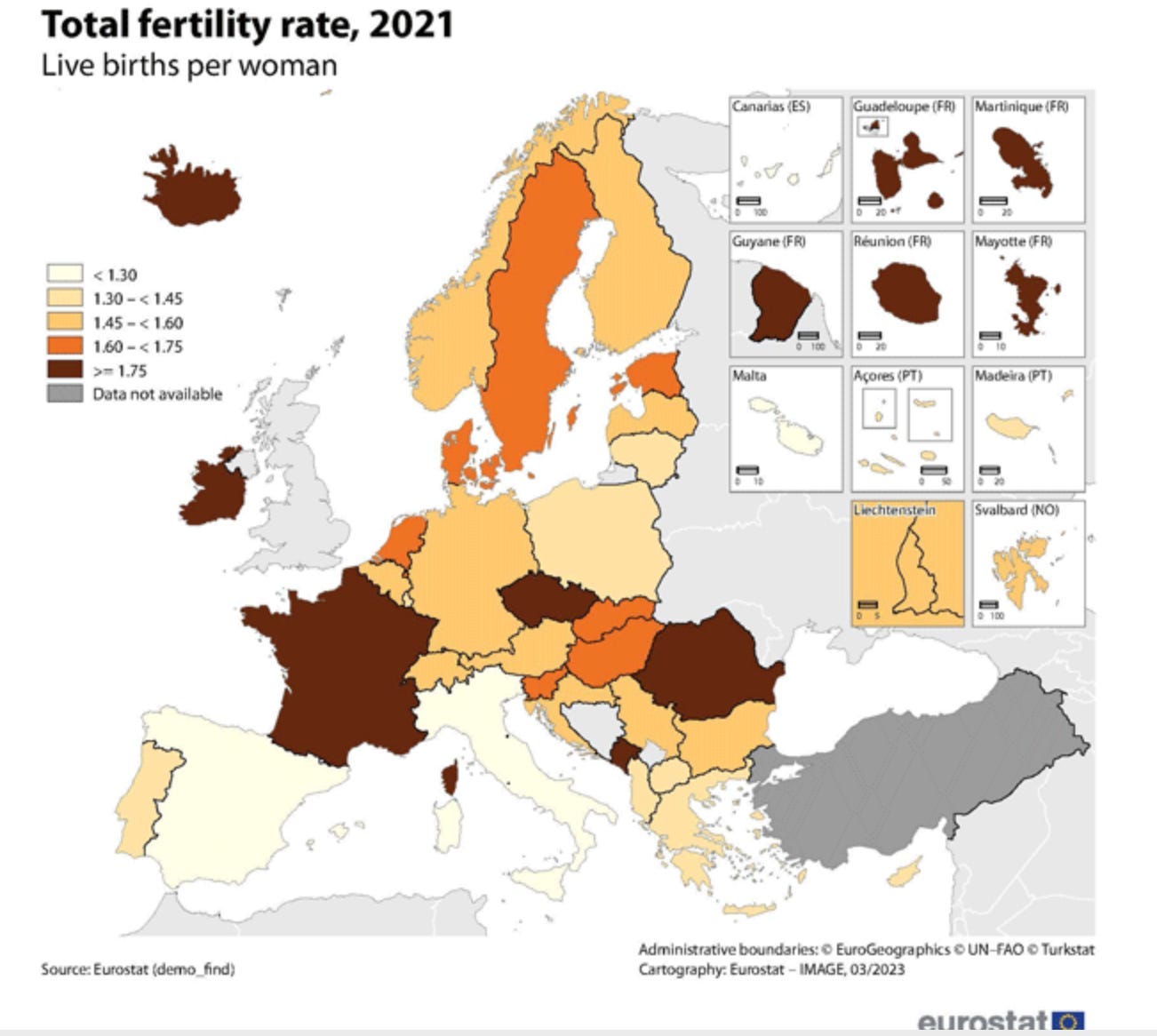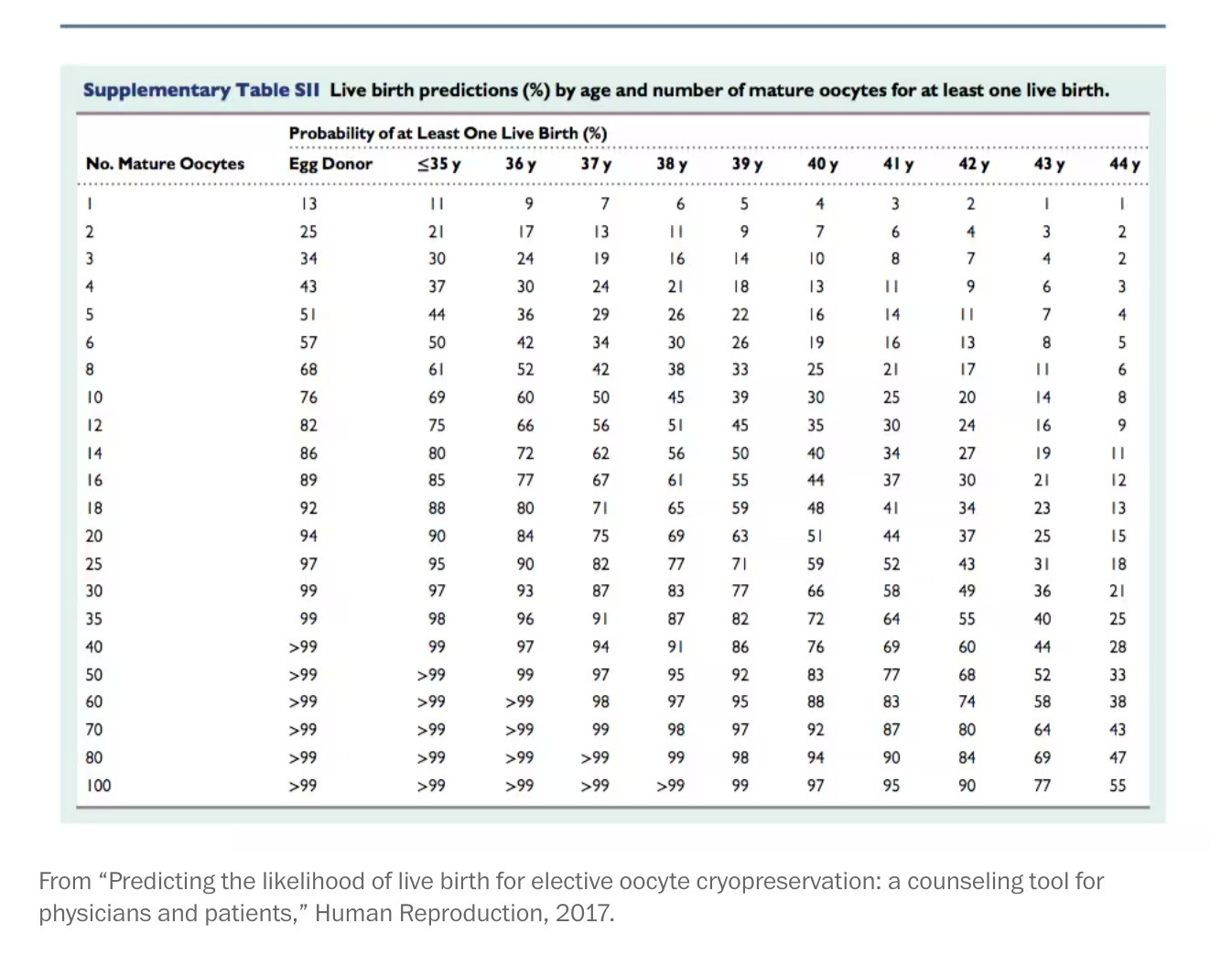Birthrates in the West are declining not because of feminism, as some conservatives argue, but because of industrial development. The picture is clear: every developed nation suffers from lower birthrates when modernity emerges. An inverted economic order reshapes communities. Contemporary Europe demonstrates that feminism is ultimately inconsequential to this trend. The opposite is true: the more feminist countries in the West have higher birthrates.
Southern European nations, such as Spain, Greece, and Italy, rank lower in female employment and political participation than Northern European countries. Southern Europe is also more religious than France and Scandinavian countries. Yet southern European nations have significantly reduced birthrates than the more feminist countries in the north among the native population - not merely the immigrant one, as critics suggest. The map below illustrates this reality. Data from last year is roughly the same.
Southern European countries are largely poorer that their northern cousins and suffer more negative economic outcomes. Here we see a fatal mixture of economic deadlock, few opportunities and an inversely inter-generationally dependent society—new generations are increasingly dependent on older ones to survive.
In relation to the demographic crisis, we often hear: “People had children in far worse conditions” or “What about poor African countries with high birth rates?” The fundamental difference in the West is that whereas once children were an economic benefit to the family, they now represent a cost.
In agrarian societies, children contribute to a family’s labor, enriching its economic output. Thus, having children was a material benefit. This is why developing nations have higher birth rates: They need children to sustain their families. Child labor is normalized: children help with household work, including caring for the elderly.
In our post-industrial society, the opposite is true. Having children is a financial cost that parents bear to their economic disadvantage. Couples increasingly wait to “afford” children, spending years establishing careers to pay for the costs. For the Boomers, this was less of a challenge. Benefiting from a prosperous post-war economy, many could afford houses and childcare at a younger age. Today, it’s harder for Millennials and Gen Z to pay off their mortgage (if they can even get one in the first place) or to make ends meet. Of course, having children is inherently joyful under any circumstance, but disadvantageous material conditions are powerful forces that must be reckoned with.
But economic factors alone do not suffice. There are spiritual and psychological issues stemming from the post-industrial period that require careful analysis. The decision to have children was historically rooted in faith and a belief that life is an inherent good, or even a necessity. Paganism and Christianity, faiths that have shaped the spirituality of the West, are both on the side of life, however different their conceptions of it might be.
The relative lack of faith in a creator in secular societies contributes to the decline in family formation because life lacks a transcendent purpose. Without faith, it becomes challenging to believe in oneself, let alone in the future of humanity. This is why we often hear, “I don’t want to bring children into this world”. In modern Western societies, pursuing a pessimistic mindset, precludes taking risks, living spontaneously, and trusting divine judgment. That includes the idea that having children, even in a less than ideal world, offers them the opportunity to improve it.
At the same time, even if some Millennials might be economically well-off and spiritually minded, relationships are more complex to create and maintain. Technological advances make our interdependence less obviously necessary, even at the cost of increasing isolation. We should be wary, however, of romanticizing the past. Many couples before the romantic period stayed together not because they wanted to but because they had to. Marriage was not just an obligation under the eyes of the Church, but a social structure created to bind couples, and society, together. Today we have choice. This means relationships are more valuable because they are born out of love and not necessity alone. That also makes them rarer.
Furthermore, we are increasingly shaped by commercial enterprise. Just as with commodities, we are presented with the idea that other people can be easily replaced. In Zygmunt Bauman’s Liquid Love, he notes that modern relationships become fluid, much like the economy.
A stagnant economy, a lack of spiritual meaning, and relational challenges make family formation rarer. Having children later, if at all, becomes the norm. Some who want children tragically miss out on the opportunity. While the more profound economic, spiritual and psychological issues are addressed, harnessing technology to mitigate this risk is vital. Here, we can create a synthesis between tradition and progress: the tools of modernity can be used for our posterity.
The West can learn from Israel’s high birthrate.
Israel’s birthrate is almost three children per woman, a number which has remained steady, with some spikes, since 2010. The Orthodox community has an average birthrate of six children per woman, while observant Jews who are non-Orthodox have an average birthrate of four children per woman. Even though religion is likely the primary cause of high fertility, the birthrate among secular, non-observant Jews is higher than 2.2, above the replacement level. This starkly contrasts the average birthrate in Europe, which stands at 1.5.
Judaism allows all forms of Assisted Reproductive Technologies (ARTs), which were sanctioned by Rabbis, who base their support on the Biblical commandment “be fruitful and multiply” (ARTs are allowed in Islam, too). The Israeli government, as a result of rabbinical approval and an enriched economy, offers generous national health insurance coverage for almost unlimited access to expensive medically assisted reproduction, including IVF, egg freezing, surrogacy, and related interventions.
According to another study, Israel scores a similar average age for a woman’s first child as most Western countries, if not older. This finding suggests that the higher number of subsequent children might be because of coverage for ARTs and generous support for new families. Jewish families who struggle to sustain new children or who decide to postpone their child-bearing years can take advantage of these modern tools.
But another causal link that Europe can learn from Israel is their ethnic pride. Wanting to continue their bloodline is a strong motivating factor for secular Jews to have children, too. In Europe, we must recreate a healthy, loving view of our ancestry and the survival of our people without falling into the trap of absolutism and hatred of others.
France provides a good model here, having the highest birthrate in the EU despite being the most secular country in Europe, standing at 1.8 among native French women, while immigrants in France have a birthrate of 2.6 - the native birthrate is still higher than most EU countries.
France provides full coverage for egg freezing and IVF, and a generous family allowance. Indeed, this seems a more effective strategy than Hungary’s tax exemptions for new families, despite the relative religiosity of the latter country: positive reinforcements work better than negative ones, such as tax deductions. As soon as you mention the word “tax”, people don’t feel as excited.
But there are Catholic objections worth considering.
Despite the low birth in southern Europe, the Catholic Church opposes ARTs. By contrast, the Anglican and Orthodox Churches allow egg freezing and IVF provided that embryos are used (though all Christian denominations oppose surrogacy). The Catholic Church objects to the creation of multiple embryos where some will likely be discarded.
From their perspective, conception is God’s will alone and should occur naturally within marriage.
The Catholic Church could nevertheless sanction the use of ARTs, provided that no embryos are discarded in the process and under the condition that they are created within a marital union. In a recent interview I had with a fertility specialist, he remarked that with recent developments in technology, single-embryo transfer is possible, and the remaining embryos can be stored for later use. In Italy, no embryos can be discarded by law, which means many remain frozen indefinitely, though this is still considered sinful in the eyes of the Church since they will likely die regardless. But it appears increasingly possible to create the number of embryos one wants.
If you’re Catholic and waiting for the Church to approve ARTs, Catholic hospitals have, in the meantime, developed two alternatives to IVF: Intrauterine Insemination (IUI) and Gamete Intra-fallopian Tube Transfer (GIFT). While the success rates are lower than IVF or egg freezing, they remain viable alternatives that governments should offer freely to their citizens.
The issue with these technologies, however, is that they are almost entirely dependent on the age of the woman attempting pregnancy. Egg freezing, on the other hand, can circumvent age the most, even compared to IVF. Here’s why it’s the preferable solution.
Egg freezing provides the best chances for successful pregnancies.
The manosphere’s belief that egg freezing creates a negative incentive for women to have children later is incorrect. A study found that women across OECD countries, especially in Europe, desire more children: around 2.8, while men’s is slightly lower at 2.6. Women also possess a stronger drive to have children at a younger age, since their window of opportunity is smaller.
First designed for women undergoing cancer treatment, “social freezing” allows women to preserve their oocytes at the age of retrieval (generally between 25-35). Though the process is identical to IVF, the difference lies in how eggs are frozen at the time of retrieval and stored for later use; unlike IVF, where fresh eggs are immediately used to create embryos. If women freeze their eggs under the age of 35, they should have an average 90+% chance of one live birth with 20 frozen eggs, an 80+% chance with 15, and a 70+% chance with 10. Here is a chart showing success rates based on the number of eggs frozen and the age at which they were stored:
The future of life in the Western world depends on its ability to make the best of the advances it has made.
We should aim for a vision where the economic, spiritual and psychological reasons for lower birthrates in post-industrial society can be fixed alongside the judicial use of technology. For example, the internet can bring together new communities with shared values in real life. Automation can help us replace tedious labor so we can afford increased time with children. We can restore our spiritual longing. In the meantime, however, women should consider egg freezing in their most fertile years to prolong their ability to have children. Our governments should fund these technologies on the basis that they are responsible for harnessing and redistributing scientific advances that humanity has brought about.
We do not live in an ideal world. We live in a complex one.
While we embrace history’s inevitable cycles, we can also shape its destiny. The industrial revolution, which caused us to have fewer children, has simultaneously produced a science that, despite its many faults, carries the potential to overcome our declining birthrate. We are living in a period of profound transformation. Why not use our inventions to bring about more life, to flourish and grow once more?
*Additional scientific evidence: No increase in risk of genetic abnormalities has been found in children born from frozen embryos compared to natural pregnancies in a study, a slight, though small increase in risk of childhood cancer has been found in children born from frozen eggs (0.03%) compared to natural pregnancies (0.01%) in another study.
Alessandra Bocchi is the founder of Alata Magazine and Rivista Alata.








‼️
One just has to choose to do it, regardless of impact on cost and time. If you want it bad enough, it will happen. Most younger generations want to travel, be influencers, bloggers or rich and child free. Many men also feel pressure to be “established” before courting women, and feeling as though they need to have something to offer, and unfortunately, this is the truth. Both sexes also hold out for their “perfect” scenario to transpire, or perfect “partner”, all the while aging and ending up 40 in a blink of an eye.
We need to go back to marrying and breeding as a matter of duty, rather than a matter of
Love and satisfaction. This is the only way in a developed nation.